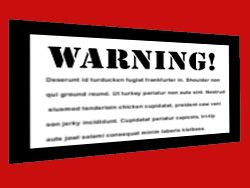- About
- Organization
- Organization Overview
- Dean’s Office
- Department of Bioengineering and Therapeutic Sciences
- Department of Clinical Pharmacy
- Department of Pharmaceutical Chemistry
- Quantitative Biosciences Institute
- Org Chart
- Research
- Education
- Patient Care
- People
- News
- Events
Drug information resources may miss parts of boxed warnings
By David Jacobson / Wed Sep 28, 2011

An analysis by UCSF faculty members from the Schools of Pharmacy and Medicine has found that the half-dozen most reputable electronic drug information resources—tools commonly used by clinicians to make prescription and patient monitoring decisions—may not provide key elements of some medications’ black box warnings.
Such warnings are the most serious the Food and Drug Administration can issue for marketed prescription drugs. Highlighted by a border in a drug’s prescribing information found in the product’s package insert, the boxed warnings alert clinicians to a drug’s association with potentially life-threatening adverse reactions and provide ways to reduce the risk or minimize such reactions’ severity.
In the study published in September 1, 2011 edition of the American Journal of Health System Pharmacy, the UCSF researchers selected 71 drugs with unique boxed warnings as of June, 2010. Pharmacist-authors independently compared nonverbatim summaries of black box warnings on the resources with the highlights of key boxed warning points included in the prescribing information (PI).
“We decided that resources’ summaries should, at minimum, contain all the information in the PI highlights for a given drug,” write co-authors Christine Cheng, PharmD, Carrie Fu, PharmD, Chairman of the Department of Clinical Pharmacy B. Joseph Guglielmo, PharmD, and Andrew Auerbach, MD, MPH.
The analysis found 52 “major” discordances between the drug information resources and the prescribing information.
Major discrepancies were defined as when a resource failed to mention a serious adverse reaction, did not include information about a drug’s restricted distribution, or omitted “discussion of steps to reduce the risk of, minimize the severity of, or manage an adverse reaction.” Most missing content fell into the latter category, such as patient monitoring recommendations.
Such omissions “may lead prescribers to make uninformed or misinformed decisions about the use of a drug,” write Cheng et al. And even resources presenting boxed warnings verbatim were sometimes outdated.
This latest analysis is especially significant since the authors’ previous research found “there is no official repository of boxed warnings… health providers must rely on drug information resources.”
But the authors conclude: “The current PI may be the most reliable approach to accessing the complete, up-to-date boxed warning for a given drug.”
Tags
Keywords:
Category:
Sites:
School of Pharmacy, Department of Clinical Pharmacy, PharmD Degree Program
About the School: The UCSF School of Pharmacy aims to solve the most pressing health care problems and strives to ensure that each patient receives the safest, most effective treatments. Our discoveries seed the development of novel therapies, and our researchers consistently lead the nation in NIH funding. The School’s doctor of pharmacy (PharmD) degree program, with its unique emphasis on scientific thinking, prepares students to be critical thinkers and leaders in their field.



